 Thoughts
Thoughts  Science, Technology, Nature
Science, Technology, Nature  Expansion of the Universe as a cartoon
Expansion of the Universe as a cartoon
Expansion of the Universe as a cartoon
This article provides some evidence for the Big Bang scenario for our Universe. I've taken an intuitive and inductive approach to show how one thing follows another and is at least consistent conceptually, but it is not a proof of said scenario.
One of the biggest problems in science communication, at least in physics, is the visualization of the concepts. There seems to be a fair bit of resistance to including diagrams which are little more than cartoons into a serious physics presentation. I didn't see it often enough when I went to conferences or public interest lectures. My office had fair resistance to the idea too, although I managed to cajole him into including at least one cartoon of the physics involved. His initial argument was along the lines of "The pictures are out-of-place, or perhaps too childlike, to include in a serious physics talk." I paraphrase as it was a few years ago but I think the notion of including cartoons, essentially simplified diagrams, into presentations of lectures is vastly underrated. Here I present some evidence the creation and expansion of the Universe in cartoon form....
Before I get to the pictures I will just add there were many diagrams and pictures used in the lectures of my degree but I still feel that there could have been more. Even a flow diagram of processes, or even of thought processes, could have helped to visualize and understand the concepts involved. Especially so when the concepts involved as difficult to grasp, and perhaps it would have been a better alternative to looking at pages of code when I once attended a computational physics lecture as an undergraduate. In the latter case the professor admitted that looking at code in a lecture was pretty much a waste of time (although this is my interpretation of what he said and thus I hope to avoid to libel in case this comment is found and good will is lost). Perhaps we could have been given some basic diagrams of what a class or an object actually is? Simply stating that a dog is an example of a class and that a greyhound might be an object in that class (or whatever). Even an abstract diagram (eg Venn) or a flow chart would have helped. Again, I reiterate, simple pictures are vastly underrated. So here goes....
Evidence
This article is one of the view places where my website can bring value to the web by going beyond what is easily found on wikipedia or other sites. While wiki has thorough lists of events that occur in the universe I believe there is enough of a gap in the information presented that I can provide an illustration of how the Universe evolved. Firstly, I will sketch some simple pieces of evidence that point in the direction of the Universe having a beginning.
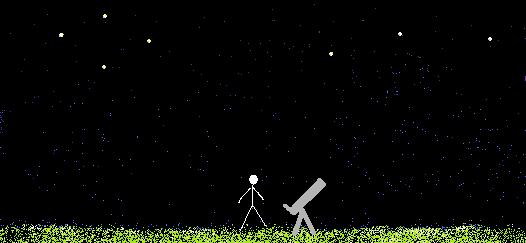
1) The night sky
For centuries man has looked up to the heavens and always wondered <insert topic here>. The first piece of evidence is that the sky at night is dark. A seemingly innocuous observation until we consider Olber's paradox. It would be impossible to go through a brief history of the universe (tm) and not mention it. In short, the paradox is an illustration that if our Universe was infinite in extent then should it not have infinite brightness? A caveat worth noting here is that a universe of infinite extent would not necessarily have infinite brightness but rather constant brightness (that of the surface of a star).
Naturally, one can begin to question that if our universe is not infinite in spatial extent then why must it also have an infinite past? One does not guarantee the other but from induction we can intuitively guess that one might follow the other. In my mind, Olber's paradox is that seed of doubt. There are some models that suggest various ways in which the universe can have infinite extent but a finite age (colliding d-branes or whatever), or infinite age but finite extent (some models of inflation), but there are many natural reasons why we can conceive of a 'first moment' or a moment of creation.
Importantly, it is from observations of the sky that we draw almost all of our conclusions about the universe and how it has evolved. We can see stars and galaxies and from there we can try to predict how they move and they they are there in the first place.
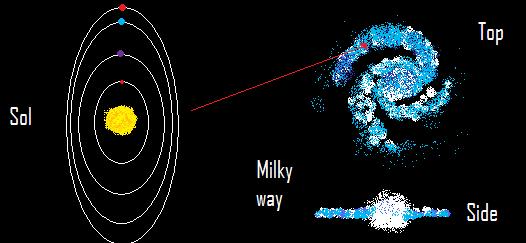
2) Solar system
I can't remember the exact reasoning for including this picture. The first picture shows a someone standing on the surface of the Earth with a telescope pointed into space. In the second picture we can see an illustration of our Solar System on the left. The planet upon which the person from the first picture stands is the little blue blob, third one up from the Sun (the big yellow blob).
This big yellow blob, with its 8 planets, is like many other stars in our galaxy (The Milky Way). As an aside I remember two people laughing in one of my first year astronomy lectures when the lecturer said "and everyone knows that the Sun is a star." They looked at each other that suggest both humour and horror; neither knew that the Sun was a star. This piece of knowledge is essentially a given in any astronomy course. This brings me to the right side of picture where I roughly show where our Sun sits in relation to the millions of other stars in our galaxy. The "Top" part is a top-down view of galaxy, or as you would see it externally and from above. While "Side" is the view that you see of our galaxy as an external observer from the side. The terms "top" and "side" are arbitrary but they do relate to common notions that we hold of 'top' and 'side'.
Drawing this picture has also shown my how difficult it is to draw a good spiral galaxy. This is attempt number 5 or 6, I think.
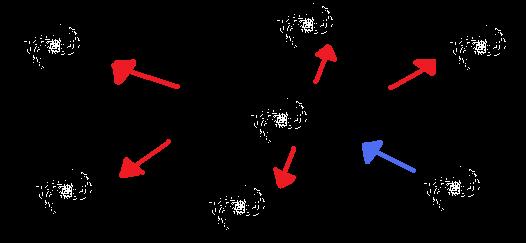
3) Redshift
Ok, so let's consider the fact that we have observe several thousand galaxies in our universe and that we believe there are millions of them. Not all are spiral but that isn't so important for this article. Let's try imagine millions of the galaxies that I have drawn above, each with millions of suns (stars) and millions of planets. All of the light produced will eventually reach us here on Earth, one day. So back in picture one we can imagine that light from all these galaxies will eventually fall into the telescope of my stick person.
The galaxies form a pattern on our sky which is random but statistically describable. That is to say that we can describe how the galaxies are attracted to one another and at what speed they should do this. The galaxies are subject to gravity and should behave in a way that we understand. We don't believe that galaxies behave in arbitrary random ways which is completely unknowable. Such a pattern can be modelled on a computer as I did in my PhD, or as the professionals did in the Millennium Simulation.
Now let's have a look at picture 3 and consider the concept of redshift. The galaxy in the centre of the picture is supposed to be our galaxy, as seen in picture 2. The pattern we see in our observations is that most galaxies seem to be moving away from us. Not just away from us but also from each other. There is a mutual repulsion, where it looks like we are all trying to push away from each other. As you would expect there are some galaxies moving towards us, which I've illustrated above by having one of the galaxies moving towards our galaxy (see the blue arrow).
We know that the other galaxies are moving away from us because the light coming from those galaxies looks more red than it should be. Light that is emitted from the stars displays certain spectral lines that we can match up with spectral lines from light sources we can create on Earth. That is to say that Hydrogen can absorb and emit light at particular frequencies (colour) that we can easily measure here on Earth. We can then compare this with the light coming from stars and see that light has some resemblance to the that of Hydrogen. The caveat is that from far away galaxies this light appears more red than we expect, hence the term redshifted.
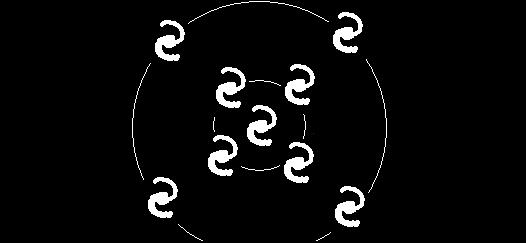
4) Not a grenade
Naturally this leads to one of the crucial pieces of evidence for the Big Bang and hence the proposed "moment of creation". If most of the galaxies that we observe are travelling away from us, and that this is true in all directions that we look, then we could naturally guess that the galaxies were once all sitting at the same point in space. If I hold a bag of tennis balls and then proceed to throw them away from me in random directions then they will form an obvious pattern. An outside observer will observe the positions of all the tennis balls (the distribution) and draw the conclusion that they must have all come from the same source (Slazenger, parum-chh).
The thought experiment of tennis balls is similar to a grenade. Once a grenade explodes it sends shrapnel out in different directions, but all of the shrapnel came from one point. The universe, however, is not a grenade. While it seems that all the galaxies came from one point, the pattern created on the sky is not consistent with a grenade model. Furthermore, our laws of physics do not predict a grenade-like model either. The key is in something I mentioned above for picture 3: the galaxies are moving away from each other with mutual repulsion. Let me provide the caveat that repulsion is just a simple term to aid visualization and is not to be considered as a physically real force. There are a few subtleties there that I wish to avoid in this article.
Somehow all the galaxies are moving away from each other, but in such a way that the repulsive motion is mutual. Not like a grenade as I have drawn in picture 4, but rather as I have drawn in picture 6 below (see section 6). I mentioned that observation was one piece of evidence for this, while another is the a piece of physics theory called the Cosmological Principle. [Note that this is picture 5:]
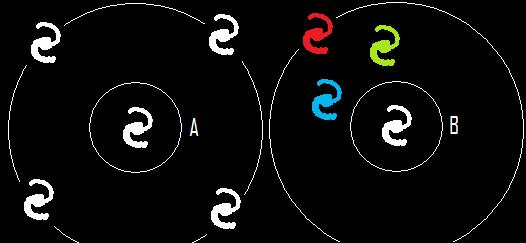
5) Cosmological Principle
This principle states that the Earth, and we as humans, do no occupy a particularly special place in the universe. That is to say that the universe exists and functions regardless of us being here, and that our piece of the universe looks pretty much like every other piece of the universe. The principle essentially enforces this rather than suggest it. If we are the galaxy A on the left side of the diagram then when we look out into the sky we should see a uniform distribution of galaxies that are all made from the same stuff. That is to say that all the galaxies on the left side of the diagram are all very similar. I have drawn them the same colour to denote that they are all made of the same stuff (homogeneous), I have shown that they sit uniformly with respect to each other (isotropy).
The converse of this principle is illustrated on the right side of the picture with us now pretending to be the galaxy B. In this picture all of the galaxies have different colours which denotes that they are all made of different material (inhomogeneous). Worse still, they are all sitting near each other in one particular direction as observed from galaxy B. We do not observe any favoured direction in the universe (insert appropriate caveat for the professionals reading this), nor do we predict this from our physical laws. The cosmological principle states that the universe is isotropic and homogeneous: it looks the same in all directions regardless of whether we stand over here, or over there. If the universe was somehow different in another part of then we'd have to ask why. One reason would be that the laws of the universe might somehow be different over there and hence the universe in that part looks far different from our own section of the universe. This does not seem to be the case.
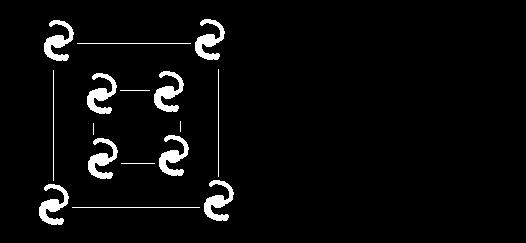
6) Expansion
Section 5 is an important aside that we believe to hold in the present day Universe as well as at the Big Bang. I now return to the main theme of expansion. If not grenade like then how? The common answer is "like a balloon" which I will show in the next picture. From the Cosmological Principle we expect the expansion to be mutually repulsive as I have tried to illustrate in picture 6 (above). Here you will try to imagine an expanding square, or an expanding cube. There is some fixed ratio that relates one galaxy to another; so while the galaxies move apart from each other there is still some notion of a fixed ratio between the two galaxies. The word ratio is perhaps misleading as I really want to say co-moving distance. This is a variable within the model that remains fixed (again, the professionals will have to accept this rough wording as means to explain something difficult in a simple manner).
The larger square with spiral galaxies at the corners could be how galaxies appear in the universe today. While the smaller square would be how the galaxies looked at some time in the past. You can imagine drawing smaller and smaller square inside each other until you reach a point. You can also draw larger and larger squares on this diagram where the galaxies at the corners get further apart.
The distance between each galaxy changes in a different way for a grenade model than it does for the model describe here. As all the points in this model expand away from each other in a mutual sense then the cosmological principle holds. A grenade model of expansion does not provide a model of the universe that is mutually isotropic from all points of view. If you stand on the furthest edge of the shrapnel of a grenade and look back towards the centre then your point of view is very different than how your point of view is at the centre itself. This is not what we want.
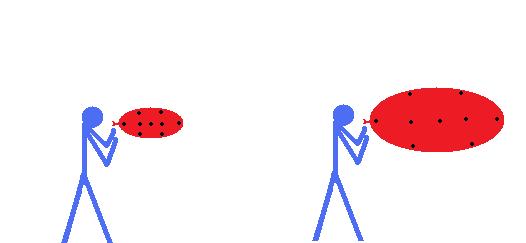
7) Balloon Universe
The balloon is an illustration of a spherical universe that is similar to the squares (or cubes) that I described above in section 6. One subtlety that is poorly explained, if at all, is that we should only consider the surface of a balloon. As we see in picture 7 above there is someone blowing up a balloon at two different times. The left side is say the universe in the distant past and the right side the universe today. The spots on the balloon are supposed to represent galaxies. These spots stay fixed with respect to each other in a co-moving sense, that is to say that the pattern looks the same in the past as it does today. The exception is that while they are fixed in a co-moving sense they do actually expand away from each other.
As the balloon expands the pattern stays the same but the spots get mutually further away from each other. The inside of the balloon, the part where we breathe air into is an extra dimension. The surface of the balloon is 2 dimensional and in this model the interior of the balloon does not exist. That is to say that there are no galaxies there, there is no matter or energy inside this balloon.
The problem here is that our universe is 3 dimensional, not 2 dimensional. So while the the surface of a balloon is 2D can cover a 3D object like a sphere, the higher dimensional model is not so easy to picture. We would have to imagine a 3D balloon surface that covers a 4D sphere. This is something that I find is missing from most descriptions on this subject matter. It was not entirely obvious to me that I was supposed to restrict my thoughts to the surfaces of objects. From reading books such as those by Stephen Hawking it was not obvious that this was the case.
The surface of the balloon in the above picture is 2D, as stated, and the dimension on the interior of the balloon represents a hyper-dimension. We can see this hyper-dimension as this balloon is actually a 3D object. This is something that we can make sense of, but an imaginary stick man that lives in a 2D world cannot visualize this third dimension. For him, the interior of the balloon is a hyper-dimension. Likewise, to model our 3D world in a similar way require a 3-dimensional surface such as that of a 4-dimensional balloon. This extra dimension is a hyper-dimension that we have difficulty visualizing.
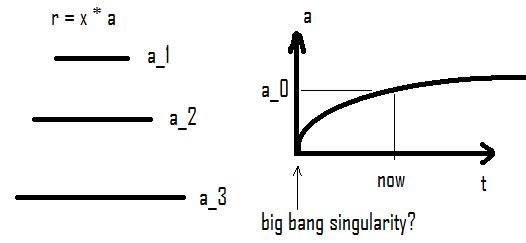
8) A vs T
The distance between one galaxy and another can be written as R which depends on two quantities: the co-moving distance X and some scaling relation A. Otherwise written as R = XA or r = xa.
The co-moving distance between two galaxies is assumed to be fixed. So if one galaxy sits at point X = 4 and another sits as point X = 2 then the co-moving distance between the two points 2. The scaling relation A is known as the expansion parameter. It is the variable that changes over time, so as the Universe expands then this variable increases. To be clearer: the letter R is the real distance between two galaxies, so while the variable X is fixed (at say 2) the variable R will increase because the variable A increases over time.
Take a look at the left side of the picture so see understand what I am saying. The ends of the lines represent the real distance between each galaxy. The lines extend over time as the universe evolves. X is fixed but R changes because A changes. A graph of how A changes over time is given on the right side of picture 8. As T increases, then A also increases. This parameter is the same at all points in the universe for a given time.
You can visualize this by considering two galaxies that are at points X = 23 and X = 15. They have have co-moving distance of 8 but the expansion parameter A will be the same for these two galaxies as it is for the two galaxies with a co-moving distance of 2 (or any other number).
The graph above on the right hand side could also be a graph of R vs T. As X is a constant between the two variable then the shape of the two graphs ("R vs T" and "A vs T") are the same. Furthermore, rather than say that R is the real distance between two galaxies I could say that R is actually the width of the universe. This is equivalent to say that there are two galaxies at the very edges of the universe (caveat: the word edge is fine for a simple illustration), where the co-moving distance is a maximum. This means that the graph above is actually a graph of how the width of the universe changes over time. Fast at first but then it slows.
Inevitably you will have looked at the words "big bang singularity", this is a logical conclusion given that we expect all the galaxies were once ''sitting on top of each other''. Given evidence and reasoning in this article it is clear to see that the universe should have be a point at some time in the past. That is a point of zero size (a singularity). There is of course further reasoning why we don't think that a singularity existed but that's for another day.
| Comments |
|
!joomlacomment 4.0 Copyright (C) 2009 Compojoom.com . All rights reserved."
Last Updated (Thursday, 28 June 2012 23:15)
© 2009 esoteriic.com
All Rights Reserved.
Joomla 1.5 Templates Joomla Web Hosting cushion cut engagement rings Joomla Templates joomla hosting


